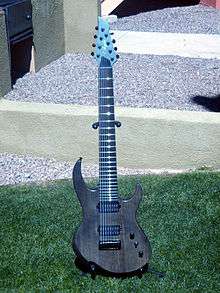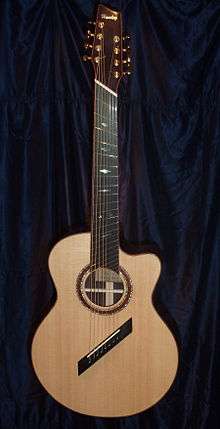Eight-string guitar


An eight-string guitar is a guitar with two more strings than the usual six, or one more than the Russian guitar's seven. Eight-string guitars are less common than six and seven string guitars, but they are used by a few classical, jazz, and metal guitarists. However, eight strings is the standard for lap steel and pedal steel guitars. The eight-string guitar allows a wider range, or non-standard tunings (such as major-thirds tuning), or both.
Various non-standard guitars were made in the 19th century, including eight-string guitars played by Italians Giulio Regondi and Luigi Legnani.[1]
In the 1940s, American lap steel guitars generally standardized with eight strings. Tuning was usually based on either the E9 chord for "Nashville" style or the C6 chord for jazz configurations.[2] Recently, eight-string guitars have become very popular throughout Heavy Metal and its surrounding subcultures and subgenres. Many believe this wave of eight-string guitars were inspired almost exclusively (at the initial point) by Swedish Progressive Death Metal band Meshuggah. Other modern artists helping to bring the eight-string into the light include Progressive Metal band Animals As Leaders, Deathcore band After The Burial, Dino Cazares of Fear Factory (He played a Ibanez LACS eight-string in his band Asesino c. 2005), Per Nilsson of Scar Symmetry, as well as a slew of Deathcore or "djent" artists.
Designs
Semi-acoustic guitar (hollow-body guitar)
Seeking a guitar-tuning that would facilitate jazz improvisation, Ralph Patt invented major-thirds tuning in 1963.[3][4][5] Patt's tuning is a regular tuning, in the sense that all of the intervals between its successive open strings are major thirds; in contrast, the standard guitar-tuning has one major-third amid four fourths.[6]
Seven-string guitars are needed for major-thirds tuning to have the E-e' range of the standard tuning.[6][7] Eight-strings enabled Patt's highest string to have G♯ (equivalently A♭) for its open note.[7] Patt purchased six-string archtop hollow-body guitars that were then modified by luthiers to have wider necks, wider pickups, and eight strings. Patt's Gibson ES-150 was modified by Vincent "Jimmy" DiSerio c. 1965.[5][7] Luthier Saul Koll modified a sequence of guitars: a 1938 Gibson Cromwell, a Sears Silvertone, a c. 1922 Mango archtop, a 1951 Gibson L-50, and a 1932 Epiphone Broadway; for Koll's modifications, custom pick-ups accommodated Patt's wide necks and high G♯ (equivalently A♭);[7] custom pick-ups were manufactured by Seymour Duncan[7] and by Bill Lawrence.[5]
Solid-body
The solid-body eight string guitar is also used in many modern bands today. The construction of a solid-body eight-string guitar is identical to seven and six-string variants. The standard tuning (from low to high, top down) is F#, B, E, A, D, G, B, E. The tuning can always be changed.[8] Many prefer to tune the F# to a low E, which gives it the same range as a Bass VI, and providing the guitar with a fuller sound by having three different E strings.
Like the seven-string, the first mass-produced eight-string guitar was made by Ibanez guitars in Japan; the RG2228
Scale Length
The main design issue faced with an eight-string guitar is tuning stability with the lower strings. This is due to the neck being constructed too short, bridge problems such as improper intonation, uneven spacing for floating bridges, or the use of wrong string gauges. Other problems associated with tuning stability rely on proper set up of the guitar.
Extended range eight string guitars sometimes will have a multi-scale design where the bass strings will be longer than the treble strings. This helps with proper intonation of the lower strings, improves string tension balance across the strings, improves harmonic overtones, overtone series, and improves inharmonicity. (See also inharmonicity in pianos).
A point of clarity, inharmonicity is not Intonation. Pressing a string against a fret — aside from raising the string's pitch by shortening the string — also causes a slight secondary raise in pitch because pressing the string increases its tension. The bass strings on an 8 string typically require the saddle to be pulled back a bit more than the other strings to properly set the intonation. Some bridge designs accommodate this by offsetting back the 7th and 8th strings or providing a bit extra room for adjustment. Longer scale lengths require less offset for proper intonation.
Notable Players
Classical
Paul Galbraith began using an eight string guitar in 1994 when in collaboration with luthier David Rubio they designed the Brahms guitar. Galbraith generally tunes (B)EADGBEA.
Alexander Vynograd tunes AEADGCEA
Egberto Gismonti (born 1947) is a Brazilian guitarist and pianist who favors the 8-string classical guitar.
Jazz
Jazz guitarist Charlie Hunter is known for playing a hybrid eight-string guitar made by Ralph Novak of Novax Guitars. Five of the strings are tuned to the standard guitar's upper five (A, D, G, B, E), while three of the strings are tuned to the standard bass guitar's three lowest (E, A, D). The bass and treble sections have separate pickups and are sent to separate amplifiers. Hunter also has a ten-string guitar based on the same principle—a combination of standard six-string guitar and standard four-string bass.[9]
Andy Lale plays an 8 string jazz classical acoustic made by brook guitars in the post jazz quartet Undiscovered Television
Heavy metal
The eight-string guitar is used by modern heavy metal guitarists such as Fredrik Thordendal and Mårten Hagström of Meshuggah, Dino Cazares of Fear Factory, Stephen Carpenter of Deftones, Justin Lowe and Trent Hafdahl of After the Burial, and others. The instrument is particularly associated with the “djent” sound popularized by Meshuggah and other contemporary metal artists.
Tosin Abasi and Javier Reyes of Animals as Leaders tune their eighth strings to the same low E as the lowest string on a standard four-string bass guitar, and use the instrument's versatility to incorporate bass guitar techniques—such as string thumping (on "Earth Departure, An Infinite Regression") á la funk bassist Larry Graham and the double thumping technique pioneered by Victor Wooten —as well as harp-like arpeggios.
Ihsahn of the black metal band Emperor began playing seven-string guitar in 1999 and first played eight-string guitar on his 2010 album After.
Rusty Cooley tunes his eight-string guitar like a standard six-string expanded in both directions, with a low B string added below the low E (as on a standard seven-string guitar) and a high A string above the high E (overall, low to high: B,E,A,D,G,B,E,A); this tuning offers both deeper bass tones than a conventional guitar and extended range in the higher register for lead melodies.
Guitarist Justin Broadrick of the English industrial metal band Godflesh introduced his eight-string playing on the 2014 Godflesh EP Decline & Fall.
See also
- Brahms guitar
- 10-string guitar
- Nine-string guitar
- Seven-string guitar
- Extended-range bass
- Harp guitar
- Eight-string bass guitar
Notes
- ↑ Noonan, Jeffrey (2008). The Guitar in America: Victorian Era to Jazz Age. American Made Music. University Press of Mississippi. p. 205. ISBN 1934110183.
- ↑ Madsen, Pete (2005). Slide Guitar: Know the Players, Play the Music. Fretmaster. Hal Leonard Corporation. p. 57. ISBN 0879308524.
- ↑ Griewank (2010, p. 1)
- ↑ Kirkeby, Ole (1 March 2012). "Major thirds tuning". m3guitar.com. cited by Sethares (2011) and (Griewank 2010, p. 1). Retrieved 10 June 2012.
- 1 2 3 Patt, Ralph (14 April 2008). "The major 3rd tuning". Ralph Patt's jazz web page. ralphpatt.com. cited by Sethares (2011) and Griewank (2010, p. 1). Retrieved 10 June 2012.
- 1 2 Sethares (2001)
- 1 2 3 4 5 Peterson (2002, p. 37): Peterson, Jonathon (Winter 2002). "Tuning in thirds: A new approach to playing leads to a new kind of guitar". American Lutherie: The Quarterly Journal of the Guild of American Luthiers (8222 South Park Avenue, Tacoma WA 98408: USA.: The Guild of American Luthiers) 72: 36–43. ISSN 1041-7176. Retrieved 9 October 2012.
- ↑ http://www.guitarcasa.com/2014/02/17/8-string-guitar-tuning/
- ↑ Alexander, Charles (2003). Masters of Jazz Guitar: The Story of the Players and Their Music. Hal Leonard Corporation. p. 180. ISBN 0879307285.
| ||||||||||||||||||||||||||||||||||||||||||||||||||||||||